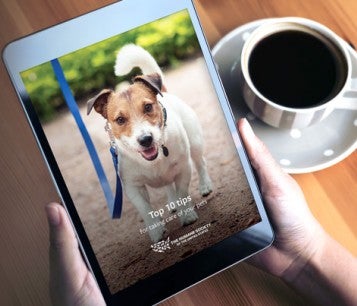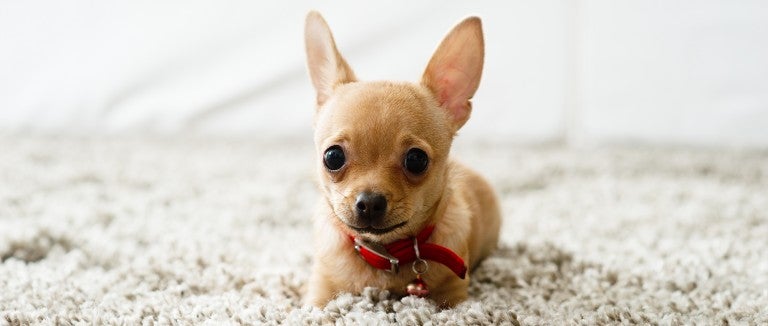Machine-washable items
Add a one pound box of baking soda to your regular detergent and wash as usual, air drying if possible. If you can still see or smell the soiling, wash again with an enzymatic cleaner—these break down pet waste odors.
If your pet soils the sheets or blankets on a bed, cover the bed with a vinyl, flannel-backed tablecloth while you retrain them. It's machine-washable, inexpensive and unattractive to your pet. Some companies are now making washable area rugs, making clean-up much easier for pet parents.
Carpeted areas and upholstery
For "new" stains (those that are still wet):
- For pet urine removal, soak up as much of the urine as possible. Place a thick layer of paper towels on the wet spot and cover that with a thick layer of newspaper. If possible, put newspaper under the soiled area as well. Stand on this padding for about a minute and repeat until the area is barely damp.
- If possible, put the fresh, urine-soaked paper towel in your pet’s designated “bathroom area.”
- Rinse the "accident zone" thoroughly with clean, cool water and blot dry.
For stains that have already set:
-
Consider renting a carpet cleaner from your local hardware or grocery store.
- To get the smell of urine out of a carpet, use a high-quality pet odor neutralizer once the area is clean.
- Use carpet stain remover if the area still looks stained after it's completely dry.
- Avoid using steam cleaners to clean urine odors from carpet or upholstery. The heat will permanently set the stain and the odor by bonding the protein into any man-made fibers.
- Avoid cleaning chemicals such as ammonia or vinegar. Strong chemical odors may encourage your pet to reinforce the urine scent mark in that area.
- Your job will be more difficult if urine has soaked down into the padding underneath your carpet. In some cases, you may need to replace portions of carpet and padding.
Sign up to receive our exclusive e-book full of important information about caring for your pet, including training techniques and answers to frequently asked questions.

Paint and wood damage
If the wood on your furniture, walls, baseboard or floor is discolored, the varnish or paint has reacted to the acid in the urine. You may need to remove and replace the layer of varnish or paint. (If you do so, make sure the new product is safe for pets.) Washable enamel paints and some washable wallpapers may respond favorably to enzymatic cleaners.
Find older messes
In some cases, old messes will have dried invisibly and be hard to locate. To find them:
- Use your nose to sniff out soiled areas.
- Examine the suspect area closely to catch hard-to-find soiling.
- If you have a black light, use it to identify soiled areas and lightly outline the areas with chalk.
Prevent future incidents
Once the area is clean, make it unattractive and/or unavailable to your pet and make the appropriate bathroom area attractive. As long as your pet can smell their personal scent, they may continue to return to the "accident zone." Keep objects that could cause urine-marking behaviors out of reach, such as guests’ belongings and new purchases.
Watch your dog when they are indoors for signs that they are thinking about urinating and calmly take them outside. When you’re unable to watch them, put your dog in a crate (if they’re crate trained) or consider tethering your dog to you with a leash when you’re distracted (like when cooking dinner) to monitor them for signs they need to urinate.
If your pet is having regular accidents, have them checked by a veterinarian to rule out medical causes. Use positive reinforcement to train your cat or dog to eliminate in the proper place.
Finally, remember that there may have been a reason why your pet chose the wrong place to eliminate. Understanding your pet's motivations will make it easier to get them on the right track again. The re-training period may take a week or more. Remember, it took time to build the bad habit and it will take time to replace that habit with a new, more acceptable behavior.
